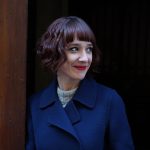The bus climbs into a greener side of Florence, and a historic villa emerges in the landscape. Approaching the gateway, a large, sloping lawn is visible, offering glimpses of the olive grove, orchard and typically Tuscan-style garden with hedges and cypresses that provide an oasis for the resident creatives to enjoy. Villa Romana is a place of contemporary artistic production and international exchange in Florence, a German-founded cultural institute dating to 1905 (the oldest German residence for artists based abroad) that awards winners of the annual Villa Romana prize with the chance to stay in the idyllic setting, networking with international guest artists and becoming immersed in the Italian art scene.

Arriving for lunch, I’m brought through the neoclassical building to the gardens in the back, where bamboo groves, magnolia and an iris-lined path lure you to wind along the perimeter wall, stopping at the various points where the city can be seen resting below. The four fellows are introduced. There’s Rubén D’hers, an artist from Caracas who works with sound, creating audio files that feature recordings of things as varied as cages, macaw feathers and refrigerators. Tuli Mekondjo, a Namibian artist, is known for her mixed media and embroidered paintings, navigating feelings of displacement after spending her childhood in refugee camps in Angola and Zambia during the Namibian War of Independence. Lima-born Sergio Zevallos answers the question “Tell me about your art” with “I use what I feel,” and certainly, exploring his portfolio, it’s difficult to categorize the works that vary from using math notebooks to public performances of a political nature. The fourth is Monai de Paula Antunes, who engages with cultural traditions of radio, producing participatory and interactive artworks that question our understanding of design.
Elena Agudio has been the director of Villa Romana since 2023, taking over from Angelika Stepken. Born in Italy and based in Berlin between 2008 and 2023, the art historian and curator, whose practice is concerned with issues of decanonization, migration and diasporic belonging, works with curator Mistura Allison in the creation of a convivial space that is exemplified at its best with the meal we share at the square table, where each individual sits in their own creativity as well as sharing it, laughter mixing with more serious reflections on contemporaneity and cultural positioning. There’s a children’s table at one side, where the kids in the creative community come together, a mere metre from the artistic installation that occupies the centre of the room, and within easy running distance to the open doors of the terrace that overlooks the city.
Beyond the sharing and expression of their various art forms, there’s an enticing cultural programme that warrants a return visit. The artists’ studios are open on request, with regularly held exhibitions and public events. From June 2 to July 14, Trattoria Guaiana is set to open in the space, “a convivial, participatory table to explore what it tastes, looks and feels like to live in a society where tradition is no longer used for ‘othering’ people and instead, it learns from every voice that contributes to its reality”. The project stems from the significant historical erasure of the attempt by the Medici to colonize the Amazon in 1608, with flavours and sensorial experiences supporting the cultures and natures that contribute to Italian tradition and identity but are still excluded from it. Guided tastings, experimental dinners, kitchen-counter chats and community conversations are designed to challenge the traditional notion of Italian identity. The typically Tuscan concept of a trattoria clashes with the plants, textiles, colours, scents and sounds of a tropical land, the now-called French Guyana. The menu features dishes like cactus tagliata, with guests learning about diasporic traditions and confronting cultural amnesia. The menu created by Pan-African chef Prince Asford seamlessly integrates simple ingredients with ancestral processes from his own background, with Alice Jasmine Crippa and Niccolò Moronato bringing their various creative practices to the experience.
















